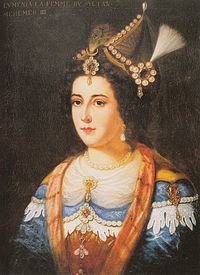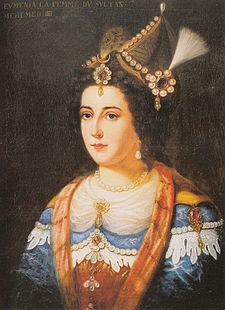Predecessor Saliha Dilasub Sultan Predecessor Turhan Hatice Sultan Name Emetullah Gulnus Spouse Mehmed IV (m. ?–1693) | Successor Saliha Sebkati Sultan Burial Yeni Valide Mosque Role Mehmed IV\'s wife Children Ahmed III, Mustafa II | |
 | ||
Tenure 6 February 1695 - 6 November 1715 Tenure 5 July 1683 - 8 November 1687 Died November 6, 1715, Istanbul, Turkey Grandchildren Abdul Hamid I, Mustafa III, Mahmud I, Osman III Great grandchildren Selim III, Mahmud II, Esma Sultan, Mustafa IV Similar People Ahmed III, Mustafa II, Mehmed IV, Turhan Hatice Su, Mahmud I | ||
Who is emetullah rabia g lnu sultan
Emetullah Rabia Gülnuş Sultan (fully Devletlu İsmetlu Emetullah Rabia Gülnûş Valide Sultan Aliyyetü'ş-şân Hazretleri; 1642 – 6 November 1715) was Haseki Sultan of Ottoman Sultan Mehmed IV and Valide Sultan to their sons Mustafa II and Ahmed III. She was the last imperial concubine to be legally married to an Ottoman Sultan.
Contents
Who is emetullah rabia g lnu sultan
Early life

Râbi'a Gülnûş was in 1642 in the town of Rethymno, Crete, when the island was under Venetian rule; she was originally named Evmania Voria and she was an ethnic Greek, the daughter of a Greek Orthodox priest. She was captured by the Ottomans during the invasion of Crete in 1645.
Time as consort
The Ottoman army invaded the island during the Cretan War (1645–1669); she was captured as a very young girl when the Ottomans conquered Rethymno in 1645, taken as slave and was sent to Constantinople. She was renamed Mahpare (meaning "a slice of the moon") and was given a thoroughly Turkish and Muslim education in the harem department of Topkapi Palace and soon attracted the attention of the Sultan, Mehmed IV. He was famous for his hunting expeditions in the Balkans and used to take her, his favourite, to these expeditions. They had two sons both of whom became the future Sultans, Mustafa II (born 1664; died 1703) and Ahmed III (born 1673; died 1736). Ahmed was born in Dobruca during one of the hunting expeditions of Mehmed IV. Her rivalry with Gülbeyaz, an odalisque of Mehmed IV led to a tragic end. Sultan Mehmed had been deeply enamored of her, but after Gülbeyaz entered his harem, his affections began to shift, Gülnuş, still in love with the sultan became madly jealous. One day, as Gülbeyaz was sitting on a rock and watching the sea, Gülnuş slightly pushed her off the cliff and drowned the young odalisque, or according to others she ordered Gülbeyaz's strangulation in the Kandilli Palace. Some writers stress the fact that Gülnuş was a ruthless person claiming that she attempted to have her husband's brothers Suleiman II and Ahmed II strangled after she gave birth to her firstborn Mustafa, but that Mother Turhan Hatice Sultan had hindered these attempted murders.
Valide Sultan
She became Valide in 1695 when her older son Mustafa II became the Sultan. She held the position during the reign of two sons. When Mustafa II was dethroned in 1703 the populace blamed Gülnuş, for his preference for Edirne over Constantinople as a place of residence and for the general confusion of life in the capital. She did have some political importance. In 1703, she was asked to confirm and approve of the succession of her other son, Ahmed III, to the throne, which she also did. Ahmed III thought it prudent to keep her out of sight until the feeling against her had died down. And, so on her return from Edirne, she went to the Old Palace for a time. She of course had more freedom of movement and contacts than the kadıns. Quite often she accompanied her son. She visited her daughters in their palaces, took part in the wedding of her daughter Fatma Sultan at the side of her son, visited her daughter Hatice Sultan in company of the sultan, after she had given birth to a daughter. She looked at parades, visited Eyüb, received the Grand vizier and the Şeyhüislam and accepted invitations by the Grand vizier and the Bostancıbaşı (with her son). She had hass (private domains) and a Kethüda (steward) who administered them for her. Mustafa kept close contacts with his mother, he honored her demonstratively whenever there was an occasion, he sent her information, asked for her well being and received many, many horses as gifts from her. He even prohibited that anybody should stay in a house in Çorlu, between Constantinople and Edirne, in which his mother had spent a night.
She is also attributed to having advised her son to the war with Russia in 1711. In 1709, king Charles XII of Sweden settled in Bender within the Ottoman Empire during his war with Russia. He wished the sultan to declare war against Russia and form an alliance with Sweden. The sultan was rumoured to listen to the advice of his mother, who had a large influence over him. Charles sent Stanislaw Poniatowski and Thomas Funck as his messengers. They bribed a convert named Goin, formerly a Frenchman, who worked as a doctor in the palace. Goin arranged a meeting with the personal slave of the Valide, a Jewish woman, who they gave a personal letter to the Valide. They were also introduced to the Hungarian eunuch Horwath, who became their propaganda person in the harem. The Valide became intrigued by Charles, took an interest in his cause, and even corresponded with him in Bender. On 9 February 1711, Turkey declared war against Russia, as the sultan had been advised to by his mother, who convinced him that Charles was a man worth taking a risk for.
Death
For 20 years, she was the influential Valide Sultan. She died on 1715 in Edirne during the reign of her son Ahmed III just before the start of the era of prosperity and peace called the Tulip (Lâle) Era by the Turkish historians. She is buried at a tomb that is open to sky, that is near the mosque she bequeathed to be built at Üsküdar on the Anatolian side of Istanbul, called the Yeni Valide Mosque.
